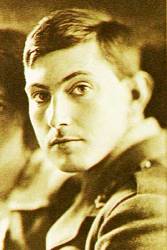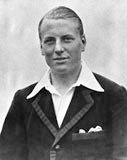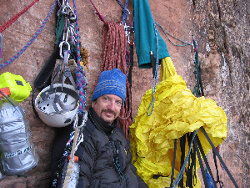
Left: George Mallory and Andrew Irvine © RGS/The Sandy Irvine Trust, from "Ghosts of Everest" ; Right: 1924 North Face locations © Pete Poston
| Photoanalysis | Routes & Maps | Video & Books | Contact Me |


"I'm quite doubtful if I shall be fit enough. But again I wonder if the monsoon will give us a chance. I don't want to get caught, but our three-day scheme from the Chang La will give the monsoon a good chance. We shall be going up again the day after tomorrow. Six days to the top from this camp!"
--from George Mallory's last letter to his wife prior to disappearing on Mt. Everest with his partner Andrew "Sandy" Irvine in 1924
"My face is in perfect agony. Have prepared two oxygen apparatus for our start tomorrow morning".
- Sandy Irvine's last diary entry

A new idea about the time Mallory's watch stopped.
© Wim Kohseik, August 7, 2013
In Pete Poston’s article: “Mallory’s Watch – does it really point to 12:50 PM?” (ref. 1), he criticizes Jochen Hemmleb’s claim that the position of two stubs that remained of the hands (the minute hand was missing when the watch was found, the hour hand was lost during subsequent transport) could be used to derive the time when the watch stopped (ref. 2).
One stub, supposedly left by the minute hand, pointed to about 10 before the hour, the other, the hour hand stub to some time after 12. In his article Pete sheds doubt on Hemmleb’s conclusion that the stubs indicate the time of 12:50 pm, which is the same the time when Odell saw the climbers negotiating one of the prominent rock steps on the ridge. Poston argues that the hour hand stub rather points to 12:15 pm or am. Obviously, the position of the minute hand stub makes no sense in that case.
I made a new analysis of the rusted remains of the hands, aided by Poston’s comments, and those of David Boettcher, the watch expert Poston consulted for his article, and I came to a conclusion that differs from both Poston and Hemmleb.

Fig.1 Left: Mallory’s watch © Rick Reanier/Archive J. Hemmleb, Lana, Italy). Right: My watch.
I possess a Borgel watch that is similar to Mallory’s (Fig.1) and I compared the hand terminals of my watch with the stubs. The minute hand and the hour hand of my watch have disk-shaped terminals. There is no reason to suppose that the hands on Mallory’s watch were different. The minute hand is on top, the hour hand under. In Fig.2, right an overlay of my watch and Mallory’s is made in which a circle is drawn around the hour hand disk terminal. It is seen that the stubs just touch this circle.
In the centre of the rusted remains a somewhat irregular shaped circular feature is seen, which I will discuss first.

Fig.2 Left, close up of the hand terminals of my watch. The picture was taken at an angle to better show the two disk-shaped terminals. The hour hand is pointing down, the minute hand up. Right, Mallory’s watch with overlay of my watch. The circle is the diameter of the hour hand disk of my watch. In the centre a circular shaped feature is seen, about half the diameter of the hour hand disk.
I asked Poston what he thought this feature might be, but we could not figure it out. Poston sent me a composite image, showing the watch after the stubs had been removed and the dial taken off (Fig. 3). I asked David Boettcher for comment and this is what he answered (In Fig.4 a sketch of the hand mounts is given which may help in understanding Boettcher’s comments):
“The picture you sent me shows at the top two views of the ends of the hour wheel pipe and cannon pinion pipe which are covered in rust. The third picture at the bottom shows the hour wheel after the rust has been cleaned off. In the picture the pipe of the hour wheel appears to be "not round" but this must be an effect on the photograph due either to the way the pipe has been cleaned or the way the subject is illuminated.”
“The cannon pinion has an extended pipe which passes through the centre of the hour wheel. The minute hand is mounted on the end of this pipe. The minute hand has a boss at its base with a round hole in it, and it mounts on the round end of the pipe of the cannon pinion by a simple friction fit. The leaves of the cannon pinion turn the minute wheel, which turns the hour wheel. There is a 12:1 reduction through these gears so that the hour hand turns once in twelve hours. The hourhand has a boss at its base with a round hole in it, and it mounts on the round pipe of the hour wheel by a simple friction fit”

Fig.3 Top, left: Mallory’s watch before cleaning, the dial is still present. Top, right: stubs removed, the dial has been taken off. Bottom, after removal of corrosion the hour hand pipe is seen as a whitish, somewhat irregular circle. The big wheel is the hour wheel, to the of it is the minute wheel. The cannon pinion can not be seen since it is under the hour wheel. The black circles (which I added) indicate the circumference of the hour wheel pipe. © Rick Reanier/Archive J. Hemmleb, Lana, Italy.

Fig.4 A sketch of the way the hands are mounted on their pipes.
In Fig.3 I fitted a circle around the cleaned hour wheel pipe and drew the same circle in the top pictures. It is seen that this circle fits the feature in the centre. This feature is thus nothing else but the end of the hour wheel pipe.
Now, if the stub at 10 minutes before the hour were part of the minute hand, it should connect with the cannon pinion pipe and thereby cover part of the hour wheel pipe. But the whole circumference of the hour wheel pipe is visible, so this stub must be part of the hour hand disk. In fact, it is not a stub at all. Nor is the hour hand stub a stub; it also is a remaining part of the hour hand disk.
Can we say anything about the position on the hour hand? It was there when the watch was found, and pointed to about 1:30, as seen in the only photograph of the watch immediately after recovery, a photograph taken by the discoverer of the watch Thom Pollard. The position of the hour hand seen in this photograph is the same position that is shown in the overlay in Fig.2. One leg of the hand is connected with the hour hand disk; the other is free because the disk is incomplete there. It is a fragile situation, which did not survive the transport down the mountain. There is no reason why the hand should be aligned with the “stub”. Any position where the hand is connected with the hour hand disk is allowed.
I communicated this with Jochen Hemmleb. Here is his answer:
“My opinion, based on the available photographs, is yet another „could be“.
The minute hand stub could be a part of the hour hand disk, which would of course carry implication as to how the stubs are interpreted.
However, the image of the stubs still give the impression that they are spatially different, i.e. one is on top of the other – but it is hard to tell.
The previous interpretation had been that the right stub had been the hour hand, based on the image that shows the remnant of the hour hand still in place.
So if what I took to be the minute hand is actually part of the hour hand disk, then all that can be said is that the watch stopped at a time between 1 and 2 o’clock – again based on the position of the remnant of the hour hand before it was lost.
In this case, the rust stains on the face of the watch might come into play again, i.e. the large stain might be corresponding to the position of the minute hand, after all.
Combined with the known position of the hour hand, this would mean that the watch stopped at c. 1:27”.
Conclusion:
I may conclude that Hemmleb no longer adheres to his earlier conclusion that the watch stopped because it was damaged when Mallory climbed a step at 12:50. Hemmleb’s suggestion that it stopped 1:27 seems to me a good choice.
- Mallory’s Watch - does it really point to 12:50 PM?, accessed 08/28/13
- Jochen Hemmleb, “Tatort Mount Everest: Der Fall Mallory”, Reich, Luzern; Auflage: 1 (22. Juni 2009)

Articles and Editorials
![]() Harvey V. Lankford, MD, has written a paper documenting the origin of the term "Glacier Lassitude" as a diagnosis for the debilitating effect of altitude as experienced by members of the early British Everest expeditions..
Harvey V. Lankford, MD, has written a paper documenting the origin of the term "Glacier Lassitude" as a diagnosis for the debilitating effect of altitude as experienced by members of the early British Everest expeditions..
![]() My new theory about Mallory and Irvine's last climb, where I believe Odell's sighting was erroneous, and have them taking the Couloir route instead.
My new theory about Mallory and Irvine's last climb, where I believe Odell's sighting was erroneous, and have them taking the Couloir route instead.
Part 1: the ascent
Part 2: the descent
![]() Warwick Pryce is a new researcher who has arrived on the scene, and he has a new theory about how Andrew Irvine could have been the first person to stand on the top of the world.
Warwick Pryce is a new researcher who has arrived on the scene, and he has a new theory about how Andrew Irvine could have been the first person to stand on the top of the world.
Wim Kohsiek has a new interpretation of what Mallory's altimeter can tell us based on scientific applications of meterology.
Mallory and Irvine researcher Wim Kohsiek has two new thought-provoking articles about Mallory's watch and Irvine's location:
Mallory's Watch - Does it Really Point to 12:50 PM?
1924 Oxygen by Richard McQuet and Pete Poston
Why the Camera and Film are not Doomed to Destruction!
The Politics of Mallory and Irvine
Why Andrew Irvine Will Not be Found in a Sleeping Bag! Part 1 and Part 2 on ExplorersWeb
Chomolungma Nirvana: The Routes of Mount Everest
Rust Marks on Mallory's Altimeter
Mystery of Mallory and Irvine's Fate Google Earth Tour - my own ideas in 3-D with audio!
Little Known Free-Solo Ascent of the Second Step in 2001 by Theo Fritsche - I should never have written this - Anker and Houlding deserve credit for the first free ascent
Criticisms of the 2004 EverestNews.com search for Irvine --
The Mystery of Mallory and Irvine's Fate (with J. Hemmleb): Part 1, Part 2, Part 3, Part 4, Part 5.
Mallory and Irvine - Comments on the 'real Second Step' route: Part 1 and Part 2
Conrad Anker's comments on the unlikeliness of a direct route up the prow of the 2nd Step
Articles about my heroes Walter Bonatti and Chris Bonington --
Spilling the Beans - Lino Lacedelli's Book "Price of Conquest: Confessions from the First Ascent of K2" Part 1 and Part 2
The Life and Climbs of Chris Bonington, Part 1, Part 2, Part 3, Part 4, Part 5 final - interview
About Me
 Celebrating my 50th birthday on pitch 3 of Prodigal Son, Zion National Park, Utah
Celebrating my 50th birthday on pitch 3 of Prodigal Son, Zion National Park, Utah
In my free time, I love to photograph and hike the spectacular redrock wilderness of the Colorado Plateau - please visit my Colorado Plateau Homepage.
And for most of my life I've been fascinated with the history, people, and culture of the Himalayas and Karakoram - browse my Mount Everest Trek (1996), Overland Journey from Kathmandu to Lhasa (2000), and K2 Base Camp Trek (2007) webpages.
As for my employment, I work for Western Oregon University where I have been a Professor of Chemistry for the last 20 years. My research interests are in applications of Laser Raman Spectroscopy to such diverse fields as Nanotechnology, Analytical Chemistry, and even a bit of Achaeology through the study of rock art pigments found in the Colorado Plateau. You can access my academic webpage here.

Copyright (c) 2004-2022 Pete Poston. All rights reserved. Visitor's Agreement |